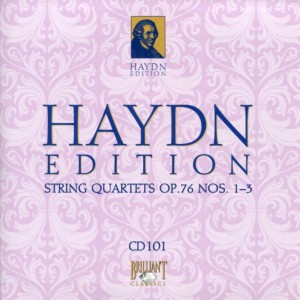 After hearing string quartets that seemed to lack luster (or maybe my ears lacked luster and the string quartets were brilliant), Opus 76 seems to have been just the prescription this winter-weary doctor ordered. For himself.
After hearing string quartets that seemed to lack luster (or maybe my ears lacked luster and the string quartets were brilliant), Opus 76 seems to have been just the prescription this winter-weary doctor ordered. For himself.
From Movement I (“Allegro con spirito”) onward, Op. 76 No. 1 in G was terrific, even the much…m-u-c-h…slower Movement II (“Adagio sostenuto”) couldn’t dampen my enthusiasm for this string quartet. Why? Because there were a few interesting/clever solo violin passages that made me sit up and pay attention. (I literally did that; I sat up straighter and listened more intently.)
No. 2 in D Minor was no less captivating, nor was No. 3 in C. All featured lively passages as well as slow-but-compelling passages.
It’s hard to say what’s different about these string quartets compared to most of the previous ones. How does one describe a peach? One doesn’t. One merely bites into it and lets the juice run down his chin.
So I can’t hope to describe why Opus 76 resonated with me. I’m just very glad Brilliant Classics saved the best string quartets for last, for that is indeed what I’m listening to. These are layered, textured, clever, mature string quartets, the last Haydn composed according to this article on Wikipedia:
Joseph Haydn’s string quartets, Op. 76 were composed in 1796 or 1797 and dedicated to the Hungarian Count Joseph Erdödy. The six quartets are the last complete set that Haydn composed. At the time of the commission, Haydn was employed at the court of Prince Nicolaus Esterházy II; around the same time he composed his annual mass for Princess Maria Hermenegild Esterházy and the oratorio The Creation.
Although the quartets were completed by 1797, shown by accounts of visitors hearing them performed in early 1797, because of an exclusivity agreement with Count Erdödy, they were not published until 1799. Correspondence between Haydn and his publishers reveal that there was confusion regarding the release of his quartets; the composer promised the London publishing house of Messrs. Longman Clementi & Co. first publishing rights, but a lack of communication with the firm led Haydn to worry that a Vienna publication might accidentally release the complete set of quartets first, causing him to lose money from London. Indeed, they were published almost simultaneously by Clementi in London and Artaria in Vienna in 1799.
These quartets are among Haydn’s most ambitious chamber works, deviating more than previous quartets from the expected sonata form, and emphasizing thematic continuity, seamlessly and continually passing motives from one instrument to another.
The entire Wiki article is worth reading. It’s fascinating background.
All of these Opus 76 string quartets (Nos. 1-3) are FAVORITES. I’d listen to them again, which is more than I can say for 95% of Haydn’s music. It’s all great, especially performed by the masterful Buchberger Quartet. But these compositions were particularly delightful.
Here’s what I listened to this morning:
Haydn String Quartet Op 76 No 1 in G
Haydn String Quartet Op 76 No 2 in D Minor
Haydn String Quartet Op 76 No 3 in C
There’s something about Movement I (“Allegro”) of No. 3 in C that reminds me of an Irish reel. Somewhere near the middle (and again 3/4 in) of this unusually long (over 10 minute) first movement is a passage that smacks of Celtic music.
As I have in previous posts, I can’t forget to introduce the members of the Buchberger Quartet (their site is in German):
Hubert Buchberger violin
Julia Greve violin
Joachim Etzel viola
Helmut Sohler cello
The other players in the quartet do not have their own web sites, apparently. So, no link to them. Sorry.
I’d like to personally thank the Buchberger Quartet for providing us with such extraordinary music. Ii feel like I’m saying good-bye to old friends. But all good things…
The next CD begins Piano Trios.
I’m ready for a change.
